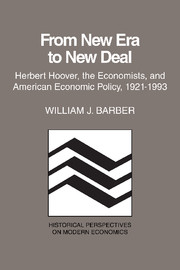Book contents
- Frontmatter
- Contents
- Preface
- Prologue: The vision of a new era in the 1920s
- 1 The ingredients of a model of a new economics
- 2 Challenges to the new economics of the 1920s
- 3 The new economics at center stage in 1929
- 4 Activating the stabilization model in late 1929 and 1930
- 5 Preliminary readings of the results of the stabilization strategy
- 6 The unraveling of the first official model in 1931
- 7 Shifting course in late 1931 and early 1932
- 8 Renewing the offensive in February and March 1932
- 9 The economists and their views on policy for 1932
- 10 Official model II as shaped in May 1932 and the aftermath
- Epilogue: Transition to the New Deal – continuities and discontinuities
- Notes
- Selected bibliography
- Index
6 - The unraveling of the first official model in 1931
Published online by Cambridge University Press: 19 October 2009
- Frontmatter
- Contents
- Preface
- Prologue: The vision of a new era in the 1920s
- 1 The ingredients of a model of a new economics
- 2 Challenges to the new economics of the 1920s
- 3 The new economics at center stage in 1929
- 4 Activating the stabilization model in late 1929 and 1930
- 5 Preliminary readings of the results of the stabilization strategy
- 6 The unraveling of the first official model in 1931
- 7 Shifting course in late 1931 and early 1932
- 8 Renewing the offensive in February and March 1932
- 9 The economists and their views on policy for 1932
- 10 Official model II as shaped in May 1932 and the aftermath
- Epilogue: Transition to the New Deal – continuities and discontinuities
- Notes
- Selected bibliography
- Index
Summary
The year 1931 was to mark a turning point in the way the Hoover administration thought about the problems of the economy and about the forms of intervention it was prepared to use in addressing them. Even though there had been slippages and disappointments in the programs pursued in 1930, there were still some grounds for satisfaction. The cooperation of the big capital spenders, of the large employers, and of the monetary authorities had, on the whole, been gratifying. It thus appeared that the worst damage had been contained. On balance, there seemed to be no reason to depart substantially from the course of policy already charted. Accordingly, the president called again for a continuation in 1931 of the same efforts to accelerate capital outlays and to sustain wages. And he asked for still further appropriations for federal spending on public works projects that could be set in motion without delay. This implied that the Treasury would have to increase its borrowings to cover the deficit anticipated for fiscal year 1931. In his budget message to the Congress, Hoover observed that he did not regard this as a matter of great concern, though he believed it prudent to contain the magnitude of the deficit by suspending the modest tax concession that had been awarded in the preceding year.
By the early spring of 1931, there were also some heartening signs that the worst of the crisis had passed.
- Type
- Chapter
- Information
- From New Era to New DealHerbert Hoover, the Economists, and American Economic Policy, 1921–1933, pp. 104 - 124Publisher: Cambridge University PressPrint publication year: 1985
- 1
- Cited by



